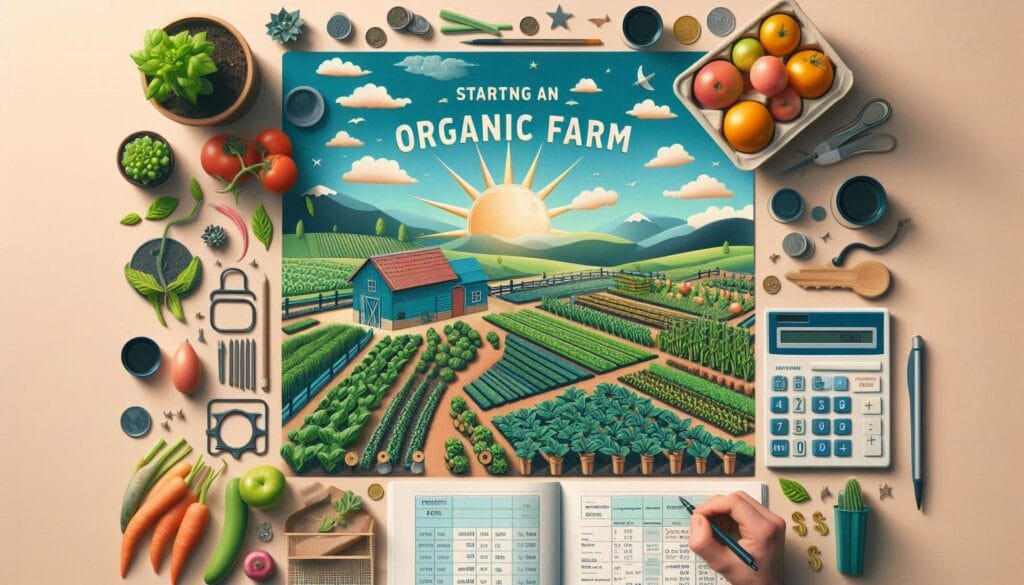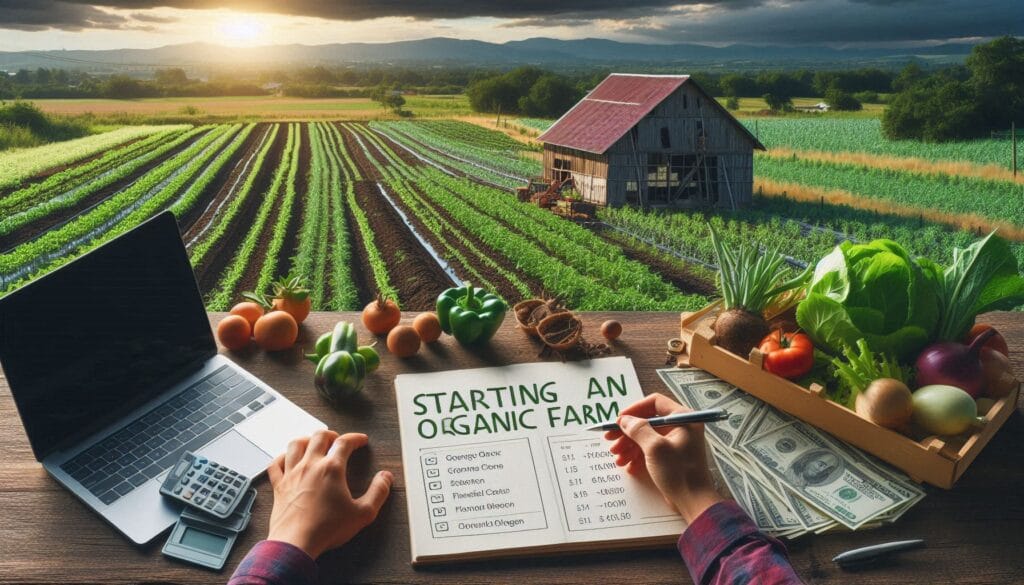Starting an organic farm can be both exciting and challenging. While the vision of growing sustainable, chemical-free produce is inspiring, the financial aspect of setting up and running an organic farm is often daunting for many new farmers. Proper financial planning is essential to ensure a smooth transition into organic farming while minimizing risks. In this blog, we will guide you through budgeting and managing costs effectively during your farm’s first year.
Why Financial Planning is Crucial for Organic Farmers

Organic farming often requires higher initial investments compared to conventional farming due to certifications, organic seeds, and sustainable infrastructure. However, with careful financial planning, you can:
- Avoid Overspending: Stay within your budget and prevent financial strain.
- Maximize Returns: Allocate resources efficiently for the best outcomes.
- Achieve Long-Term Goals: Lay a strong foundation for future growth and profitability.
Step 1: Assess Initial Costs
The first step in budgeting is identifying the costs involved in starting an organic farm. Here’s a breakdown:
1. Land Acquisition or Lease
- Cost Factors: Location, size, and fertility.
- Tip: Consider leasing land initially to minimize upfront costs.
2. Soil Testing and Improvement
- Cost Factors: Testing kits, laboratory analysis, and amendments like compost or lime.
- Tip: Prioritize soil health as it’s the foundation of organic farming.
3. Infrastructure Setup
- Greenhouses, irrigation systems, fencing, and storage facilities.
- Tip: Opt for scalable infrastructure that can grow with your farm.
4. Certification Fees
- Certification is crucial to market your produce as organic.
- Tip: Research local certifying bodies and budget for their application and inspection fees.
5. Equipment and Tools

- Basic tools: Hand trowels, wheelbarrows, and shovels.
- Larger investments: Tractors or tillers (if needed).
- Tip: Consider buying second-hand equipment in good condition to save costs.
Step 2: Estimate Recurring Costs
After calculating initial costs, focus on recurring expenses that you’ll face throughout the year:
1. Seeds and Fertilizers
- Organic Seeds: Ensure they are certified organic.
- Fertilizers: Compost, manure, or other natural amendments.
- Tip: Bulk purchases can reduce costs significantly.
2. Labor Costs
- Hiring skilled workers for planting, weeding, and harvesting.
- Tip: Explore family labor or community support to lower expenses.
3. Water and Energy
- Irrigation and electricity for equipment.
- Tip: Invest in rainwater harvesting and solar-powered systems for long-term savings.
4. Marketing and Distribution
- Packaging, transportation, and promotions.
- Tip: Leverage social media for cost-effective marketing.

Step 3: Explore Funding Options
Starting an organic farm doesn’t have to drain your savings. Several funding options are available to help new farmers:
1. Government Grants and Subsidies
- Many governments offer financial aid to promote organic farming.
- Tip: Research schemes like organic farming subsidies, training programs, and low-interest loans.
2. Community-Supported Agriculture (CSA)
- Sell shares of your farm’s future harvest to local consumers upfront.
- Tip: This provides immediate cash flow and builds customer loyalty.
3. Loans and Credit
- Seek agricultural loans from banks or cooperatives.
- Tip: Prepare a solid business plan to secure funding easily.
4. Crowdfunding Platforms
- Platforms like Kickstarter or GoFundMe can help raise funds for specific projects.
- Tip: Share your organic farming story to attract supporters.
Step 4: Create a Realistic Budget
A well-structured budget is your roadmap to financial success. Here’s how to create one:
1. Divide Expenses
- Categorize costs into one-time (infrastructure, certification) and recurring (seeds, labor).
2. Set Priorities
- Focus on essential investments first, like soil health and irrigation.
3. Monitor and Adjust
- Regularly track expenses and tweak your budget as needed.

Step 5: Plan for Unexpected Costs
Farming is unpredictable, and unforeseen expenses are inevitable. To safeguard your finances:
- Build an Emergency Fund: Allocate 10-15% of your budget for contingencies.
- Get Insurance: Consider crop insurance to protect against natural disasters or market fluctuations.
Step 6: Calculate Expected Revenue
Understanding your potential income helps balance the budget. Estimate revenue based on:
- Crop Yield: Expected harvest quantities.
- Market Prices: Current rates for organic produce.
- Value-Added Products: Diversify with products like jams, pickles, or organic teas.
Example
If you plan to grow organic tomatoes on one acre and expect a yield of 20,000 pounds at $2 per pound, your estimated revenue is $40,000.
Step 7: Leverage Technology for Financial Management
Several tools and apps can simplify budgeting and expense tracking:
- Farm Management Software: Tools like Farmbrite or Tend help track expenses and revenue.
- Spreadsheets: Create custom templates for detailed tracking.
- Mobile Apps: Use apps like QuickBooks for small business accounting.
Conclusion
Financial planning is a critical component of starting an organic farm. By assessing costs, exploring funding options, and creating a realistic budget, you can set your farm up for long-term success. Remember, the key is to start small, prioritize essentials, and continuously monitor your finances. With careful planning and perseverance, your dream of running a thriving organic farm can become a reality.
Here are 5 quick questions and answers about budgeting for your organic farming
1. Q: Is budgeting really that important for a new organic farm? It seems like a lot of work.
A: Absolutely! While it might seem like a daunting task initially, creating a budget is crucial for your farm’s financial health. It’s like having a roadmap for your finances, helping you track income and expenses, identify potential problems early on, and make smart decisions about investments. Without a budget, you’re essentially navigating uncharted territory, which can be risky and lead to unforeseen financial difficulties.
2. Q: What’s the most critical thing to consider when estimating income for my first year?
A: Projecting realistic yields and market prices is essential. It’s tempting to overestimate how much you’ll produce and how much you’ll sell it for, but it’s wiser to be conservative. Research typical yields for your crops in your region and investigate current market prices for organic products. This will give you a more accurate picture of your potential income.
3. Q: I’m worried about the high upfront costs of organic certification. Are there any ways to mitigate this?
A: It’s understandable to be concerned about the initial investment in organic certification. While it’s a necessary expense for selling certified organic products, there are ways to manage it. Look into cost-share programs offered by government agencies or certifying bodies. These programs can often help offset some of the costs, making certification more affordable.
4. Q: How can I manage cash flow, especially since farming is so seasonal? It seems like a complex issue.
A: Managing cash flow in farming can be challenging, but it’s not insurmountable. The key is to anticipate periods of lower income and plan accordingly. Consider establishing a line of credit or setting aside a reserve fund to cover expenses during these times. Also, explore different sales channels that might provide more consistent income throughout the year, such as Community Supported Agriculture (CSA) programs or direct-to-consumer sales.
5. Q: What’s the most valuable piece of advice you can give to a new organic farmer about budgeting?
A: The most valuable advice is to be flexible and adaptable. Your budget is not set in stone; it’s a living document that should be regularly reviewed and adjusted as needed. Don’t be afraid to make changes if things aren’t going as planned. This proactive approach is essential for navigating the unpredictable nature of farming and building a successful and financially stable organic farm.


